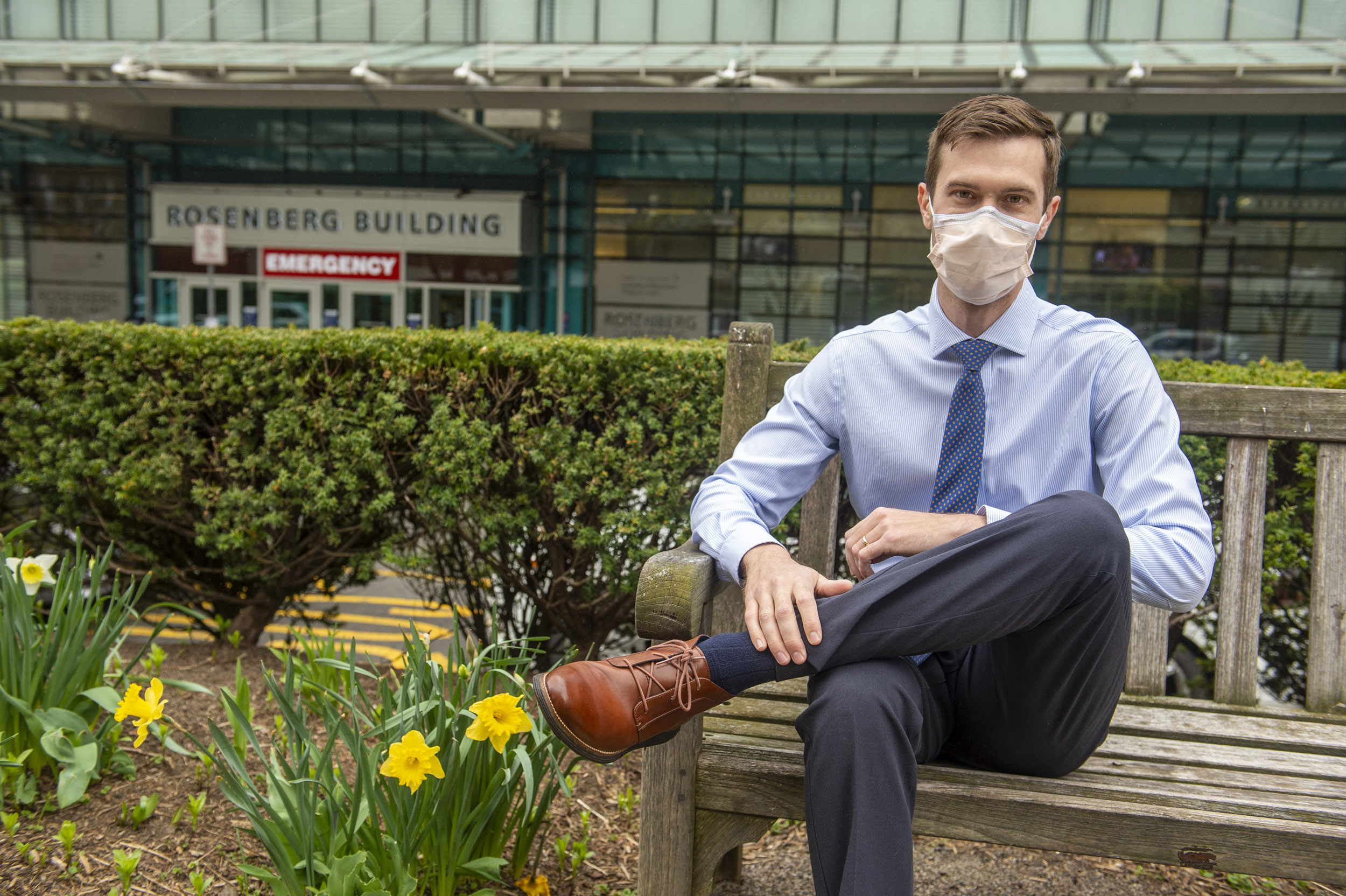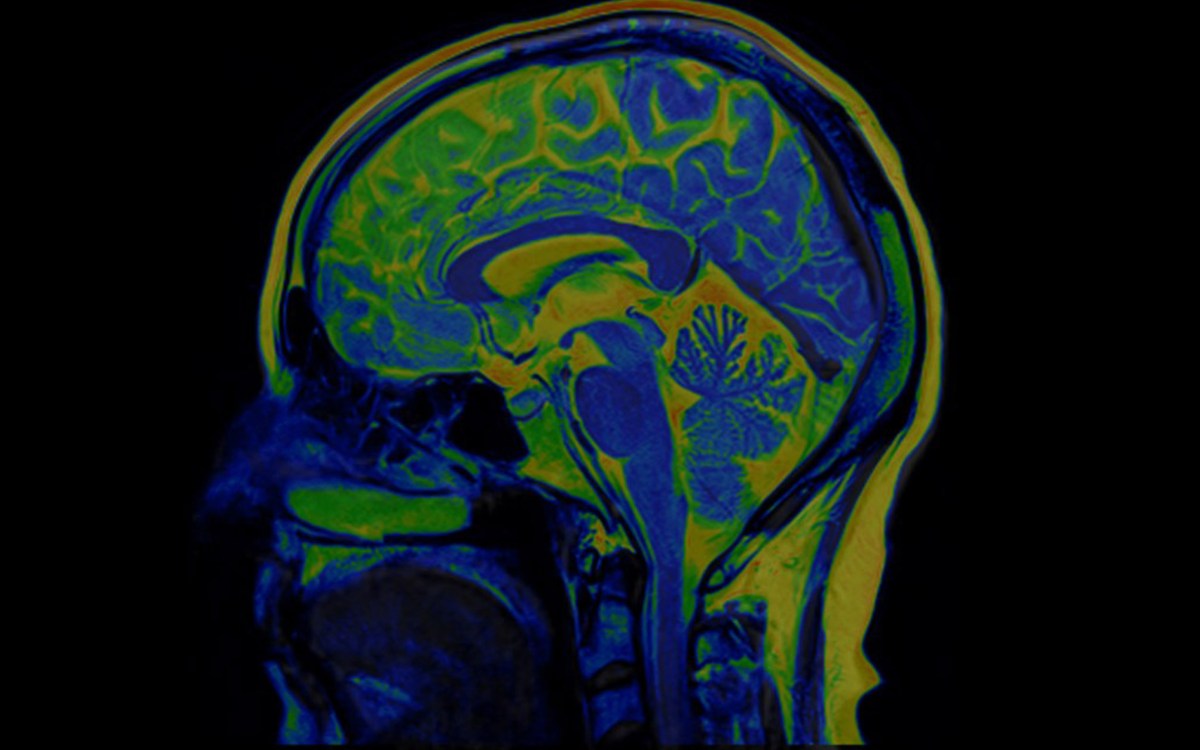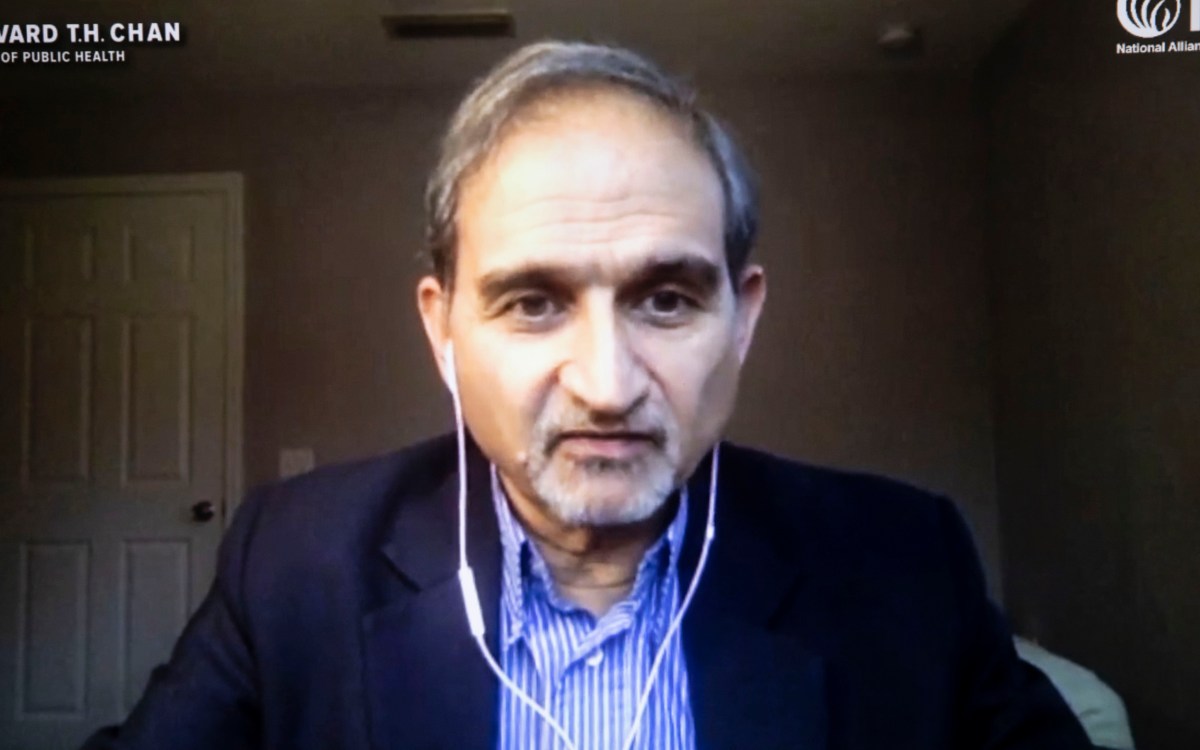
“My suspicion is that many people with COVID need at least several weeks — if not a month or two — to feel back to normal, which isn’t unusual for bad viruses,” said Jason Maley of Harvard Medical School.
Jon Chase/Harvard Staff Photographer
A pandemic that endures for COVID long-haulers
Medical School’s Maley explains Beth Israel program to treat lingering ailments
As public health officials race to vaccinate Americans amid the rapid spread of viral variants, physicians and scientists are turning their attention to a growing population of those who seem locked into COVID-19’s misery months after the acute phase has passed. These so-called “COVID long-haulers” or sufferers of “long COVID” are those who continue to feel symptoms long after the days or weeks that represent a typical course of the disease. These patients tend to be younger and, puzzlingly, in some cases suffered just mild initial conditions.
Last month, Beth Israel Deaconess Medical Center launched a new program to provide clinical care for long haulers and to investigate the mysterious source of the condition. The Gazette spoke with Jason Maley, a Harvard Medical School instructor in medicine and director of BIDMC’s Critical Illness and COVID-19 Survivorship Program, to gauge what we know about the condition and what awaits discovery.
Q&A
Jason Maley
GAZETTE: What is long COVID and how is it different from the common COVID-19 condition we’ve become familiar with over the last year?
MALEY: Long COVID or what’s now — through the National Institutes of Health — being referred to as “post-acute sequelae of COVID-19,” is persistent symptoms or new symptoms that develop, generally speaking, at least four to eight weeks after the initial infection with COVID-19. It can include the continuation of symptoms that happened when a person was first sick, like shortness of breath, or fatigue, or it can be new symptoms where a patient feels like they’ve improved and they’re recovering and then a month after being infected, they have worsening chest discomfort and brain fog and difficulty thinking, and all sorts of symptoms from head to toe that can either persist or develop somewhat newly after they’re infected.
Some people, for the initial two weeks of their infection, had just cold-like symptoms that lasted for three days. They felt like they were fine and then over the ensuing four months they are just so fatigued. They can barely breathe when they walk around, and they have these other severe symptoms that are really out of proportion to the initial symptoms.
GAZETTE: Do we know how long this lasts?
MALEY: Groups of patients follow different time courses. Some people, not uncommonly, are very slow to recover, and it takes them three to six months to get back to feeling like they have their normal level of energy and that their breathing is improving. Others are nine or 12 months out from their infection, and they still haven’t noticed any improvement. They’re exhausted all day long, and they have severe difficulty doing their jobs because of memory and thinking issues, breathing discomfort, and other symptoms.
GAZETTE: Are they infectious still?
MALEY: They’re not infectious. Most patients who have this initial improvement and then have this worsening of symptoms often go back and get retested because they’re worried they might have gotten infected again, or they could be still infectious. All of the patients I can think of who have done that have negative tests for their second test. So we, for the most part, can’t detect any ongoing infection.
GAZETTE: What is this from? Is the virus getting into places that it doesn’t in typical COVID, into the brain, for example? Or is it from something else, the body overreacting, that lasts even after the virus is gone?
MALEY: There are a few current theories related to the immune system and the manifestations of long COVID that we’re seeing. All are unproven at this point, and I think ultimately there may be several explanations for the different constellations of symptoms. We’re seeing long COVID most often in people who did not have severe COVID initially, and there may be clues that the robustness of the immune response and subsequent persistent immune activation could drive symptoms. Some have wondered if there could be low-level virus still present, although there isn’t evidence to prove that among our patients so far. Then there’s the possibility that there was initial damage from the virus — such as damage to nerve pathways that are then very slow to recover. This could explain some of the profound neurologic symptoms and pain patients experience even after mild COVID, which can take many months to improve.
“I suspect we’ll be seeing patients with this for several years to come. Hopefully we’ll learn more, and we’ll be able to help patients improve.”
GAZETTE: You already mentioned it tends to be found in younger people. Is there a specific age group or demographic that seems to be more at risk?
MALEY: We’re seeing it from teenagers to people in their 50s. That may be because young healthy people are most troubled by the symptoms and most engaged in finding answers, or there may be something unique to the mechanisms of long COVID that affects these patients most. In our clinic, because we see adults, it’s mainly people 20s to 50s. It’s uncommon for us to see someone with this constellation of symptoms who is elderly or who had severe COVID initially, though that may just be because those patients have other severe health problems that they’re seeing physicians for and doesn’t necessarily mean these patients aren’t experiencing long COVID. Overall, long COVID refers to unexplained symptoms that are usually in younger people and usually people who didn’t initially have to be in the hospital or weren’t severely sick with COVID.
GAZETTE: I saw an article recently that getting a vaccine has helped some people with long COVID. Is that likely?
MALEY: At least three or four times a day that comes up, whether it’s from patients or from physicians or because people read it in the media. Because patients with long COVID organized into social media groups through Facebook and other platforms, there have been surveys of these groups in order to understand symptoms and find other patterns. We can’t know cause or effect through these surveys, but we can describe what patients are experiencing. Two surveys suggest that a subset, maybe a third of patients with long COVID, report that their symptoms get significantly better several weeks after getting vaccinated.
It’s hard to know yet if that’s a true effect of the vaccine, through some immune mechanism, or if people are just improving with time and they’re observing that improvement. I have had patients who, pretty convincingly, after many months of symptoms, have a distinct change, a positive change, in their symptoms after getting the vaccine.
GAZETTE: If there’s no virus that we know of in the body, would that be from an immune system reset? Is there a mechanism that we might understand here?
MALEY: The vaccines all ultimately result in an antigen — a piece of the outside of the virus — being presented to the body’s immune system and then your body develops an immune response — antibodies — to that. That type of immune response could be a shift away from some other chronic, ongoing, immune activation or inflammation. That’s one theory, that when people get the vaccine, it shifts all of the activity of the immune system toward creating antibodies and then, for lack of a better term, “resets” that ongoing inflammation that was causing long COVID. There’s no direct evidence for that right now, but if there’s a true effect, that’s one possibility. Another theory is clearance of low-level remaining virus, like I mentioned earlier.
GAZETTE: How rare is this? I know it’s a subset of people who get acute COVID, but is it 10 percent, 1 percent, even less than that?
MALEY: We don’t know for sure. To get the actual percentage, there would have to be an accurate survey of a group of people who are representative of all the people who have had COVID. Most of the surveys that have been done have gone out through social media or engaged people in a way that probably over-selects for people who are looking for long COVID information or who are concerned about it. I’ve seen everywhere from 2 percent to over 20 percent. My suspicion is that many people with COVID need at least several weeks — if not a month or two — to feel back to normal, which isn’t unusual for bad viruses. Even the flu can really knock people out for a month. But for true long COVID and the prolonged severe symptoms we’re seeing, 20 percent is probably an overestimate and 2 percent may be an underestimate, so it may be somewhere in the middle.
GAZETTE: How many of these patients have you treated personally?
MALEY: We’ve seen, through clinical and research studies, about 300 or so patients. We started seeing people with severe COVID who survived the intensive care unit because we were most concerned about the sheer number of people recovering from being on ventilators. We know, from decades of research, that these patients had difficulty recovering prior to COVID, from other illnesses that required a ventilator. So, we wanted to help those patients and then long COVID came around and became probably 75 percent of the patients we are seeing now.
GAZETTE: Do you get a new patient daily or is it more like twice a week or longer?
MALEY: We’re seeing new patients twice a week. We have a team of specialist physicians and social workers and physical therapists who also work with patients separately from the initial visits that I do.
GAZETTE: Can you describe what Beth Israel is doing on this, the Critical Illness and COVID-19 Survivorship Program?
MALEY: There are clinical and research parts. The clinical part, seeing patients, involves myself and another pulmonologist, several neurologists, psychiatrists, geriatricians, social workers, and physical therapists as the core team. I see patients initially, whether they are coming out of the ICU or they’ve developed these long COVID symptoms and been referred to us or have contacted our clinic. We talk about everything they’re experiencing, head to toe, and try to prioritize what symptoms we should tackle that are most impacting their life. Then other members of our team take over, often social workers, physical therapists, and other specialists, depending on which issues they’re having. The cognitive neurologist, who specializes in thinking, sees the patients with brain fog and cognitive impairment, for example. As a team, we discuss both patients and what we’re learning in general because this is a new area. And we connect with other clinics around the country to work on guidelines, share experiences, and try to figure out what to do.
GAZETTE: So it’s a multidisciplinary team but not everybody sees every patient?
MALEY: It’s really tailored to what the patient is experiencing and what’s most impacting their quality of life because many people have gone through a roller coaster of different symptoms. And with long COVID things come and go over time. So we try to focus on what’s really impacting them.
GAZETTE: Is it both inpatient and outpatient?
MALEY: This is just outpatient. Through our Intensive Care Unit, we identify patients who are coming out who we need to see. I see some of them in the hospital before they leave, but in part because of COVID restrictions and the difficulty of seeing people as easily in person these days, we’ve focused mostly on scheduling those patients then to see us outpatient.
GAZETTE: So, because long COVID is not debilitating enough to require hospitalization, these people tend to be suffering at home?
MALEY: Most people are at home, but there are patients who have had to go into the hospital for severe symptoms — some have bad digestive issues and haven’t been able to eat adequately, for example. Various symptoms have brought patients into the hospital and people frequently visit the emergency department when they initially develop long COVID because they feel this discomfort in their chest and have difficulty breathing and their heart races. There are a lot of distressing symptoms. So they’re often seeing me after going to the emergency department or after going to their primary care doctor several times and trying to figure out what’s going on.
GAZETTE: Do you have any doubt that eventually all long COVID will resolve or might there be people who continue to struggle with it over the long term?
MALEY: That’s a tough question. The patients tend to improve over time and get back to their lives, although some people do it within four months, and for others they’re nine or 12 months out and still having severe symptoms. I suspect we’ll be seeing patients with this for several years to come. Hopefully we’ll learn more, and we’ll be able to help patients improve. A lot of what we’re doing now is focused on rehabilitation: physical activities, cognitive activities that help restore people’s function, and supportive care from our social work team. But we don’t know the underlying cause of this, so it’s not as if we have some specific treatment that gets to the root cause yet.
GAZETTE: You mentioned there’s a research portion to the program?
MALEY: We started early last year with the first surge of the pandemic, studying the outcomes of patients who are surviving the ICU, doing cognitive tests, testing their mental health, post-traumatic stress, anxiety, depression, and their physical abilities, to see over the course of the six months after leaving the ICU, how patients were recovering and what they needed. Then we did a study — not yet published — for which we interviewed patients and families to understand all the details of their experience of being isolated in the hospital, and their recovery after leaving the hospital. Now with long COVID, there’s a National Institutes of Health grant initiative and we partnered with sites throughout Boston to submit an application that’s currently under review. The aim is to bring sites together across the country that are seeing patients during and after COVID, and try to discover the cause of long COVID, using advanced blood testing and other tests to assess the impact of COVID on these patients over time.
One thing that has been overlooked, especially among young people — the demographic that often seems to have long COVID — is that the focus during the pandemic has always been, reasonably, on survival. People who are younger often weren’t worried. But we’re seeing mostly young people who are really debilitated by these symptoms. So we should keep in mind that long COVID is one of the reasons to get vaccinated as soon as you are eligible — on April 19 for all people in Massachusetts who aren’t currently eligible — and follow public health measures such as masks and physical distancing.
Interview was edited for clarity and length.








